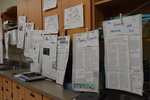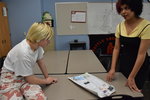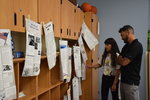


Stop the presses.
Daybreak Middle School seventh-grade students have taken a dive into the newspaper business as part the school’s annual project on civil rights activists, creating projects resembling front pages of publications to keep readers abreast on their subjects’ work.
The projects were strung around classrooms during the school’s Daybreak on Display event June 4 which featured a host of other works students had completed during the past school year. The front pages were a mix of writing and history where students became reporter, opinion writer and layout designer for articles based on the life and work of a host of activists both present and past.
Daybreak Middle School Seventh-Grade Teacher Angela Minick coordinated the project this year, a new approach to the usual end-of-the-year work involving a civil rights activist report. The project had the students writing a main article detailing their activist’s work, a letter to the editor or editorial discussing a human rights issue, a “Dear Blabbly” advice column-styled question and answer, and an editorial cartoon related to something the activist worked on.
The project started on May 6. Prior to the work on the project, The Reflector’s own editor-in-chief Jonathan Haukaas stopped by Daybreak to discuss the nuts and bolts of putting a paper together.
In previous years seventh-grade students did elaborate projects like museum exhibits, Minick said. With front pages, she explained, students had to be more specific with word choice, given the limited amount of space available for the content.
“They had to really focus on vocabulary, and that’s a thing we’ve been studying all year long, is how to use bigger words that mean more things,” Minick said.
Minick said the front page projects fit well into this year’s schedule which, due to other changes at the school, didn’t allow for something more grandiose like a full exhibit presentation. She said one of the challenges of the project was getting students to empathize with the people and situations they profiled, most of whom had challenges brought on by their race, ethnicity, gender or sexual orientation that many of the students hadn’t faced in their personal lives.
Though student population changeups coming from in-district boundary shifts next year make future plans unknown, Minick anticipated that the front-page projects would make a return in subsequent years given its success. She said doing a newspaper format on social activists made sense given how many of the subjects experienced a good deal of press coverage during their lives.
“Honestly I’m hoping that they start reading the news more,” Minick said.
Students could choose from a list of activists from prior years’ projects or could come up with their own.
Student Onalee McGuire picked Bessie Coleman, an early aviator who broke ground by being the first black woman to hold a pilot’s license.
McGuire said she knew nothing about Coleman going into the project but she grew to admire the aviation pioneer through the work. She mentioned how Coleman learned French while working as a manicurist in the U.S. in order to head to France to get her pilot’s license as no stateside flight schools admitted women or people of color.
“She was really unapologetic about how people felt about what she did,” McGuire said, adding Coleman wasn’t seeking the approval of white people or men in her pursuits.
Student Alexandria Fredrickson picked an activist currently at work as her subject, rapper Kendrick Lamar.
Fredrickson said she chose Lamar because his activism is often overshadowed by his music career; Lamar is the first artist to win a Pulitzer Prize for Music outside of jazz or classical genres.
Lamar’s ability to get his message to inner-city populations stands out to Fredrickson, recalling how Lamar was a straight-A student while avoiding involvement in street gangs that surrounded him growing up in Compton.
“I get his message through his music,” she said.
Both McGuire and Fredrickson said one of the biggest challenges was getting everything to fit just right on the page.
“It was either you have too much or you have too little. It was a tough process,” Fredrickson said.